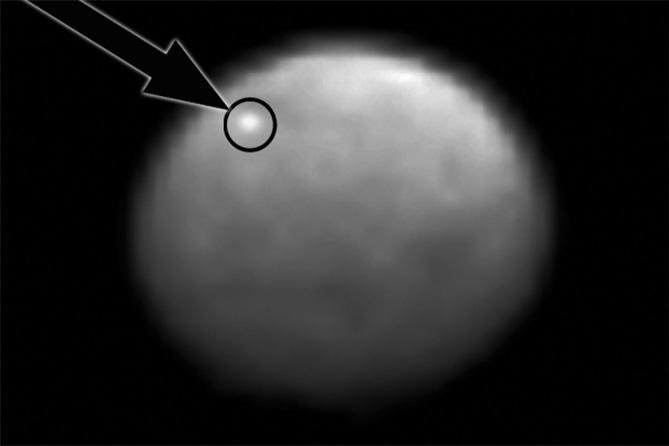A strange white spot has been observed on the surface of the dwarf planet Ceres. Photo by NASA/JPL-CALTECH/UCLA/MPS/DLR/IDA/PSI
PASADENA, Calif., Jan. 26 (UPI) -- Everyday, NASA's Dawn probe gets a bit closer to the dwarf planet Ceres. They're hoping this history-making flyby can answer questions and offer scientists a new and improved understanding of the glorified asteroid. But so far, Ceres is all mystery.
Scientists on the Dawn mission are especially puzzled by a strange shiny white spot seen on the surface of the mini planet.
Last week, as Dawn prepared to encroach upon Ceres -- it's expected to reach its closest point to the dwarf planet in early March -- the craft began sending back a series of photos of the white sphere. The resolution isn't yet an improvement on Hubble's resolution, but it was good enough to highlight the dark and light differentiations on Ceres' surface.
One of this differentiations, a white spot seen in the upper left quadrant of the planet's surface, is particularly striking. And NASA's scientists at the Jet Propulsion Laboratory in Pasadena don't know what it is exactly.
"Yes, we can confirm that it is something on Ceres that reflects more sunlight, but what that is remains a mystery," Marc Rayman, chief engineer on the Dawn mission, told Space.com last week.
"We do not know what the white spot is, but it's certainly intriguing," Rayman added. "In fact, it makes you want to send a spacecraft there to find out, and of course that is exactly what we are doing! So as Dawn brings Ceres into sharper focus, we will be able to see with exquisite detail what [the white spot] is."
Last year, scientists at NASA and ESA observed water vapor pluming from Ceres. The findings confirmed the belief that the dwarf planet's mantel is a thick sphere of ice. Some scientists have suggested Ceres could have more fresh water than Earth. If so, it's possible that the strange white spot is some sort of icy geyser -- its slick, watery output reflecting the sun.
"We've got a spacecraft on the way to Ceres, so we don't have to wait long before getting more context on this intriguing result, right from the source itself," Carol Raymond, the deputy principal investigator for Dawn, said last year after the discovery of water vapor plumes.
Now, that context is even closer to arrival.
"We know so much about the solar system and yet so little about dwarf planet Ceres," Rayman said. "Now, Dawn is ready to change that."















